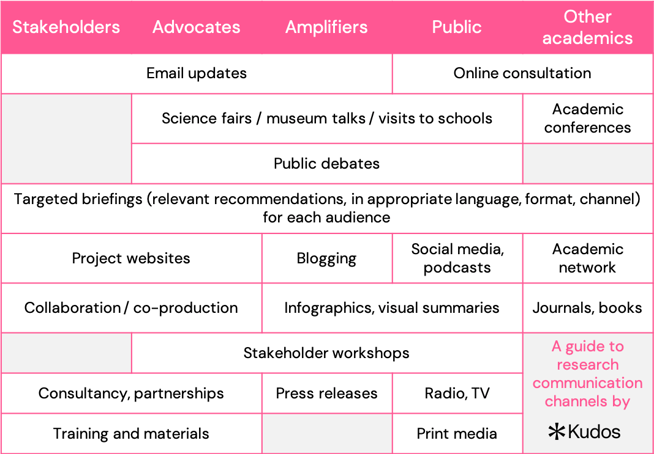Welcome to part 3 of our series on the “who, what, where” of research communication. In part 1, “who is your research for?” we looked at the different audiences for research; in part 2 we looked at “what to say so your audience will understand your research”. In this post, we’ll look at where you communicate.
Communications channels
Communications professionals talk about “channels” – the medium by which you will communicate. In my experience, researchers tend to underestimate their communication skills and knowledge. Most researchers already use a wide variety of channels to share information about their research – I am sure you can “tick off” many of the examples below as channels you have used at some point:
- Websites – maybe your own personal website, or a website / webpage for your project, or your department’s / institution’s web pages
- Scholarly communication networks – such as ResearchGate and Academia.edu
- Social media – Twitter, Mastodon, Facebook, LinkedIn
- Academic conferences, symposia, annual meetings and so on
- Workshops with stakeholders and beneficiaries
- Talks at museums, schools, science fairs and the like
- Interviews for TV, radio, podcasts and other broadcast media
- Emails – to your team, to project participants, to policy contacts or community email groups and discussion lists
- Industry consultancy
- Random encounters! I heard a great story recently from a researcher who was invited to help write a government committee’s recommendations – based on a chance meeting on a train.
One size doesn’t fit all

A simple rule of thumb to keep in mind is that there is no “one size fits all” approach to communication of any sort, research communication included. A phrase often used by communications professionals is “go where your audience is”. This is key to choosing the right channels for you and your research. If your target audiences don’t use Twitter, then that won’t be an effective mechanism for you. But if people from your target audience are likely to be at an upcoming event, then having a poster there would be a good choice. (I’m not only talking about academic posters – for some audiences an eye-catching advert-style poster in a doctor’s waiting room or supermarket / community notice board could be a highly effective way of improving awareness and uptake of your research’s recommendations).
Choosing a wide range of activities and channels can help broader audiences find, understand and apply your work. It’s also the case that funders are placing ever greater emphasis on research communications and they welcome applications that show a more comprehensive, strategic approach to channels and activities.
Picking the right channel
Lots of people struggle with knowing which of these options to pick. There is a tendency to just “do what we’ve done before”. And while people have often tried a range of things, they usually haven’t done that in a very scientific way – tracking which things are most effectively drawing the right audiences to their work. I recently led a study exploring the challenges of getting research picked up and used outside of academia. One of the researchers I interviewed for that study made the following point:
"The thing that keeps us awake is working out which channels to use to have the impact that we want.
We know the audience, and we know what we want to say, and we have a good idea of which channels we can use, we just don’t really know what works."
Industry researcher, UK
Of course, knowing what works means measuring and monitoring what you do, against meaningful goals. This is something we provide tools for at Kudos – we help you identify target audiences, set your impact goals, and then measure your efforts to achieve those goals. In developing our services, we’ve explored lots of information about how people communicate research to different audiences. I’ve summed up all that intelligence in this table showing you the best ways to reach and engage some of the different target audiences you might have for your research.
- Download slides containing this chart and graphics from the other 2 posts in the research communication series by Kudos
Getting started
To recap this series of 3 posts: the secret to research impact is making sure your findings reach their target audience. You need to work out who can act on it or benefit from it. Tell the story of your research to those people, in language they can understand. And tell it in a place they will find it. Kudos can help – we have spent 10 years helping researchers develop impact through better research communication and dissemination. Tell your research Story on Kudos and will get the ball rolling for you, with dissemination via our global research Showcase, and promotion via social media and search engines.



